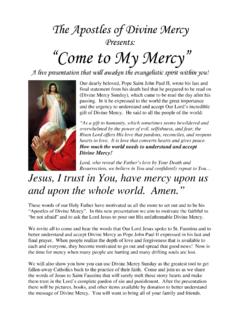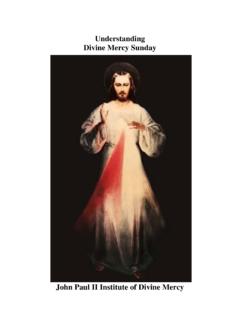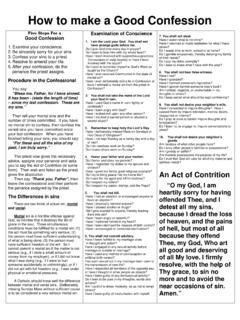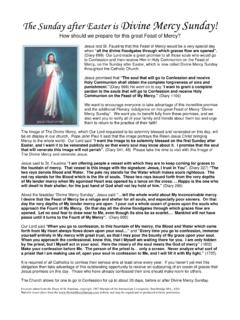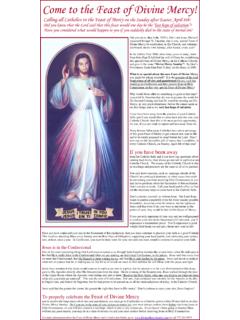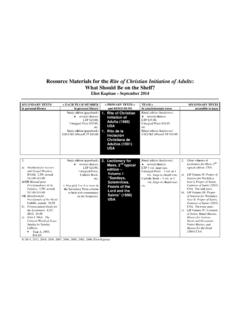Transcription of Easter Is An Eight Day Long Feast - Divine Mercy …
1 Easter Is an Eight Day Feast How can we begin to bring light to accept that Easter is an 8 day Feast ? Since the second vatican council and the Universal Norms on the Liturgical Year, the Church has been emphasizing the importance of celebrating the entire 8 days of Easter as solemnities, the highest form of celebration possible. Still, there are some that persist in their ignorance. There seems to be a reluctance on the part of many to emphasize that the celebration of Easter spans a full Eight days; from Easter Sunday to the following Sunday, Divine Mercy Sunday. This Eight day period is called the Octave of Easter and the final day is called the Octave Day. For many years, prior to the second vatican council , there had been an incorrect movement to suppress the importance of the First Sunday after Easter .
2 Some missals had gone so far as nicknaming that Sunday, Low Sunday , incorrectly, to contrast it with Easter Sunday. Slowly but surely, the light is beginning to shine. There are several factors that are helping to shine this light. They come from different Church documents, Church traditions, and some from the revelations that Our Lord has given to the Church from His prophet St. Faustina. From the Old Testament, we learn first about the importance of extended celebrations. Many of the most important feasts that our ancestors celebrated, spanned anywhere from seven to ten days. The Feast that most resembles the 8 day celebration of Easter is the Feast of Tabernacles. We can learn from the Gospel account of this Feast , that the last day of the Feast is also very important.
3 In the Gospel of John (chapter 7:37-38) we read: On the last and greatest day of the festival, Jesus stood up and cried out, If anyone thirsts, let him come to Me; let him drink who believes in Me. Scripture has it: From within him rivers of living water shall flow . The Gospel accounts that are read on Easter Sunday (John 20:1-9), and the following Sunday (John 20:19-31), span a one day and an Eight day period. The Gospel that is read on Easter Sunday recalls the Resurrection that occurred in the morning and the first part of the Gospel for the following Sunday, the Octave Day of Easter , recalls what happened on the evening of that day. The last part of that second Sunday s Gospel recalls what happened on the next Sunday. This perfectly ties in the important events on the day of the Resurrection and the next Sunday.
4 On Easter Sunday we focus on the Resurrection. On the following Sunday we focus on the first instruction that Jesus gives to His Church through His Apostles when He miraculously walks through the door in the Upper Room and institutes the Sacrament of Reconciliation. Let s recall these words in the first part of that Gospel where Jesus institutes this sacrament, Jesus said to them again, Peace be with you. As the Father has sent Me, so I send you. And when He had said this, He breathed on them and said to them, Receive the Holy Spirit. Whose sins you forgive are forgiven them, and whose sins you retain are retained. Jesus last act before His death was the institution of the Holy Eucharist. The Lord gives us the Sacrament of His Body and Blood and then His very first act, after His Resurrection, is the institution of the sacrament to prepare us for this Eucharist by the washing away of our sins.
5 This was not accidental and neither was the event with St. Thomas on the following Sunday. Have we failed to see this important connection? After years of study about the Feast that Jesus requested to be established on the Sunday after Easter as the Feast of Mercy , we can easily see His reasoning. After years of study, it is quite evident that Jesus was right on target . Aren t the Sacraments of Confession and the Eucharist, the Sacraments of Divine Mercy ? At this point in time and after years of asking why would Jesus want the Feast of Mercy on this Sunday, it is much easier just to believe in everything that Jesus said about it and start working to correct the misconceptions. Blessed Pope John Paul II did say in 1997 that he had fulfilled the will of Christ by establishing the Feast of Divine Mercy , so let s see what Christ s will is.
6 First of all, let s look at the Divine Mercy image that Jesus wants to be venerated on the Feast of Mercy . It is the image of Jesus walking into the Upper Room on the day of the Resurrection and also walking in again on the following Sunday when He showed His wounds to Thomas. We can see, in the image, the events that occurred in the Gospels, both for Easter Sunday and the following Sunday, but not only that, we also have the underlying lesson of the last part of the Gospel with the words Jesus, I trust in You that Jesus insisted be placed on the image. Wasn t that entire scenario with St. Thomas to get us to trust in Jesus without seeing Him? Jesus indicated to St. Faustina, The two rays denote Blood and Water. The pale ray stands for the Water which makes souls righteous.
7 The red ray stands for the Blood which is the life of souls. These two rays issued forth from the very depths of My tender Mercy when My agonized Heart was opened by a lance on the Happy is the one who will dwell in their shelter, for the just hand of God shall not lay hold of him . (Diary of St. Faustina, entry 299) The red ray, in a sense represents the Eucharist, our life blood. The pale ray represents the water that washes away sin in Baptism and also, as Blessed Pope John Paul II indicated, also represents the giving of the Holy Spirit which can be found in all of the other sacraments. So too does the Church teach; the Blood and Water which gushed forth from the Heart of Christ, are the sacraments being poured forth from the merits and sufferings of the Passion of Jesus.
8 In the oldest liturgical document in existence, attributed to the Apostles, the Constitutions of the Holy Apostles , where the Apostles were setting the feasts for the new Church, St. Thomas writes: After Eight days [following the Resurrection Feast ] let there be another Feast observed with honor, the eighth day itself, on which He gave me, Thomas, who was hard of belief, full assurance, by showing me the print of the nails and the wound made in His side by the spear . One of the greatest Doctors of the Church, St Gregory of Nazianzen, declares that the Octave Day of Easter is as great a Feast as Easter without taking anything away from the greatness of the Day of the Resurrection itself. The Octave Day of Easter is the fulfillment of what Easter is all about; perfect life in eternity (a second creation, more admirable, greater than the first).
9 Now let s look at the promise that Jesus made for the Feast of Mercy : Jesus said The soul that will go to Confession and receive Holy Communion shall obtain the complete forgiveness of sins and punishment. On that day are opened all the Divine floodgates through which graces flow. Let no soul fear to draw near to Me, even though its sins be as scarlet. (Diary 699). It has been said by vatican theologians that this grace is equal to the one received in Baptism. Isn t this the grace that St. Gregory was referring to; perfect life in eternity ? When we are first Baptized all of our sins and punishment are washed away. If we were to die immediately after Baptism, we would go straight to Heaven. Isn t this the Easter gift that Jesus wants us all to have on His Feast of Divine Mercy ?
10 If Easter is the world s greatest Feast , then shouldn t the world s greatest Feast offer us the world s greatest gift, a renewal of Baptismal grace? If God wants to set aside one day as a special Feast , then who can argue with that? We must not fail to remember that God did just that for the Day of Atonement, as recorded in the Old Testament. The Lord told Moses in (Leviticus 16: 29-34, 23: 26-28) And this shall be an everlasting statute unto you, to make an atonement for the children of Israel for all their sins, once a year. This is to be a lasting ordinance for Because on this day, atonement will be made for you, to cleanse you. Then, before the Lord, you will be clean from all your sins. The Day of Atonement was on the last day of their biggest Feast which lasted for ten days.
